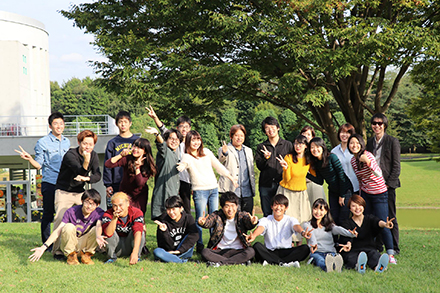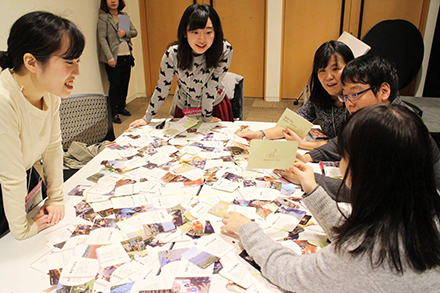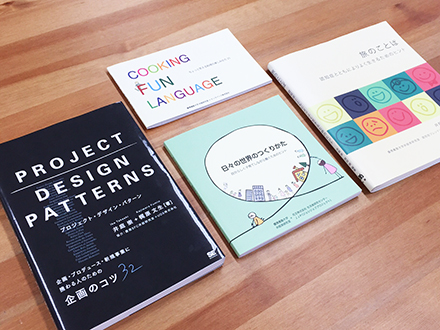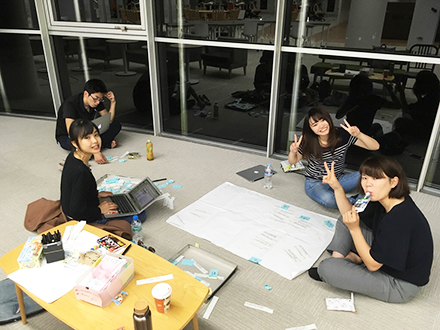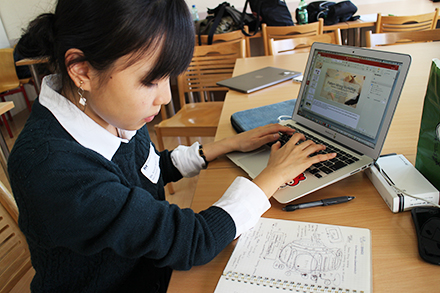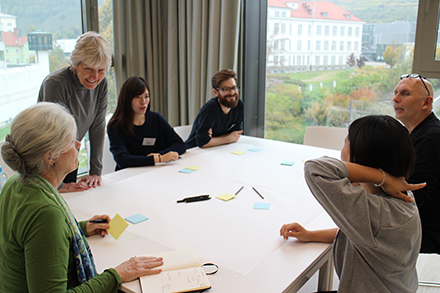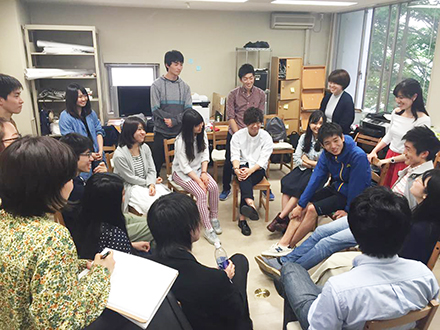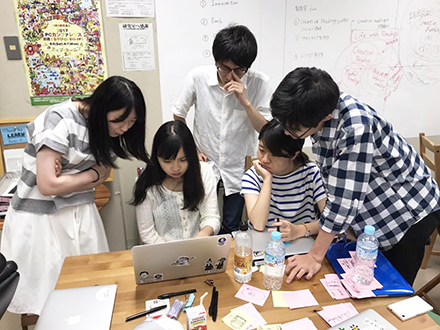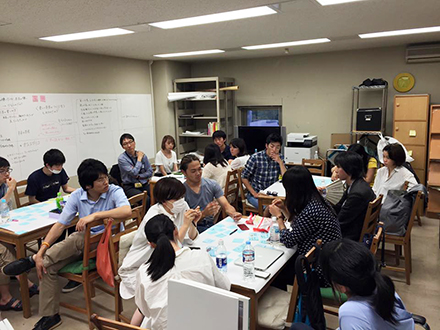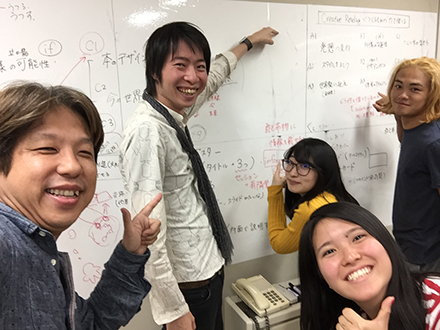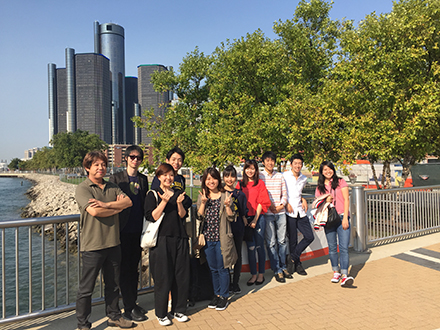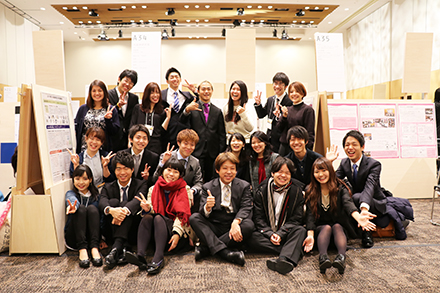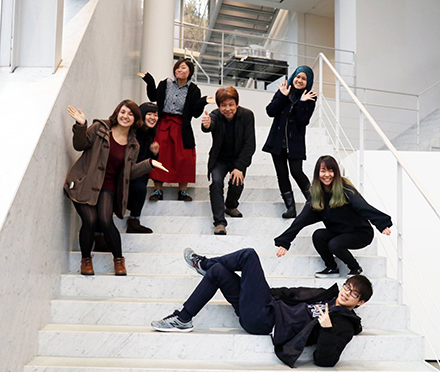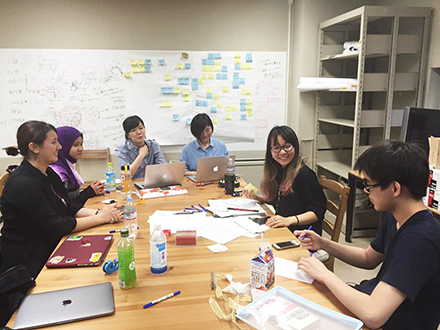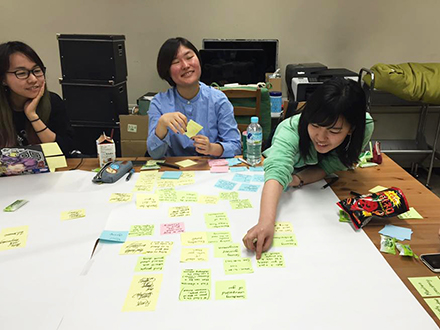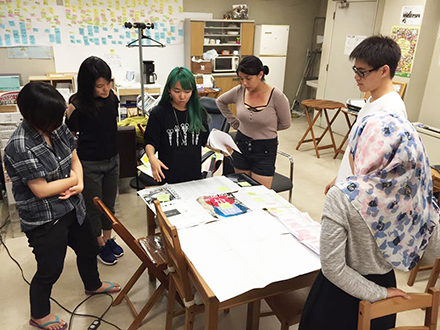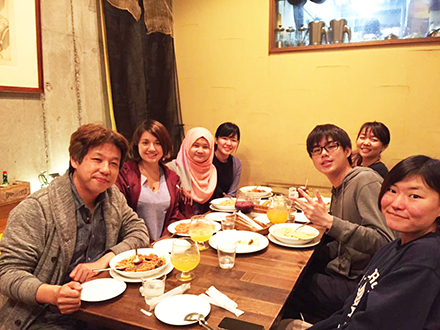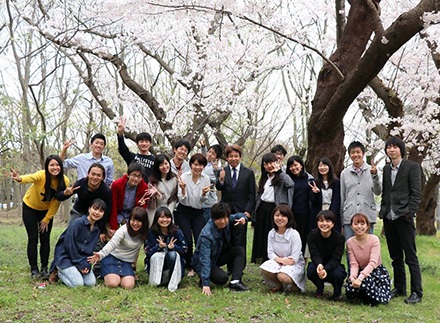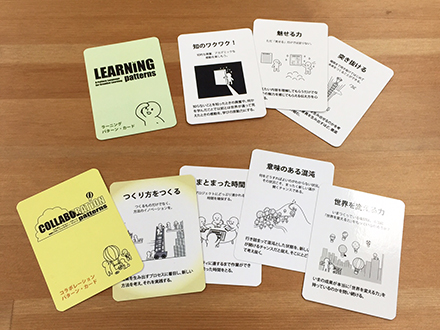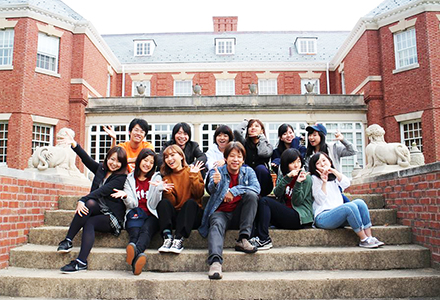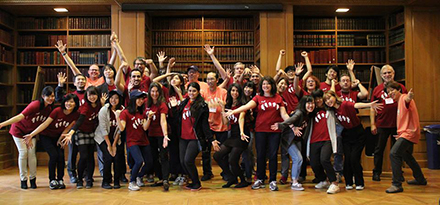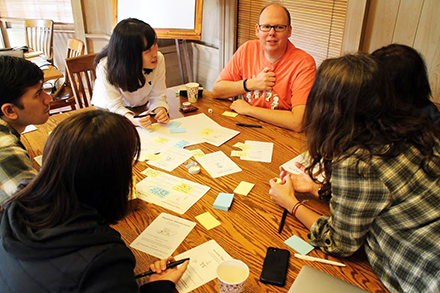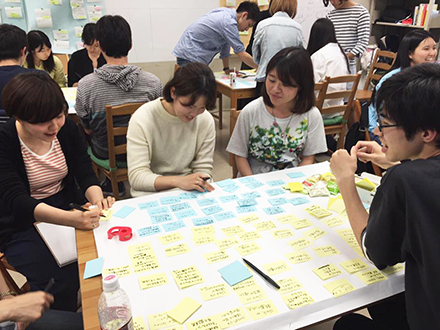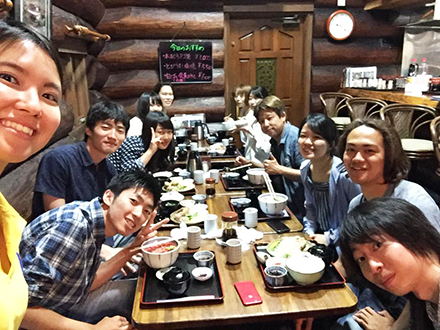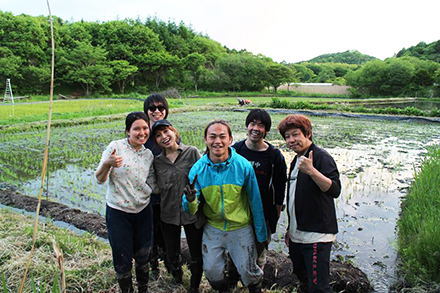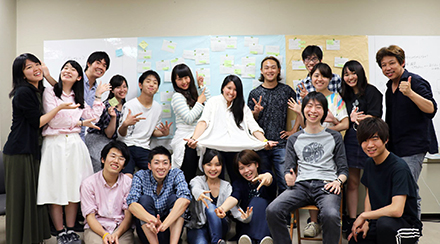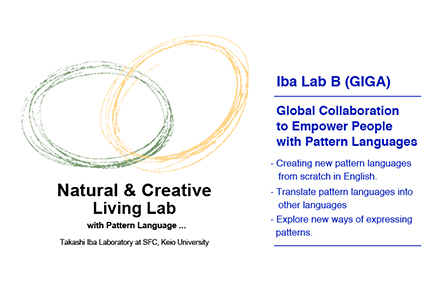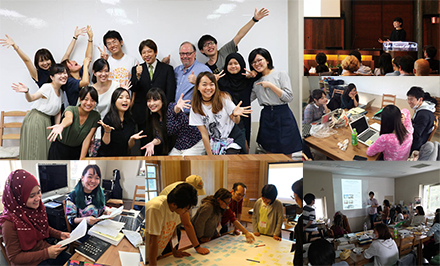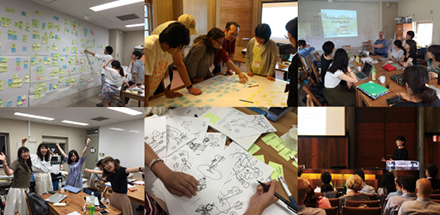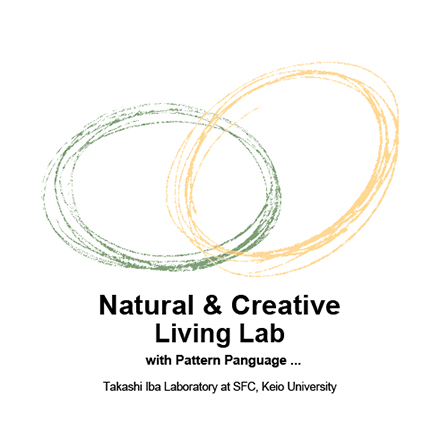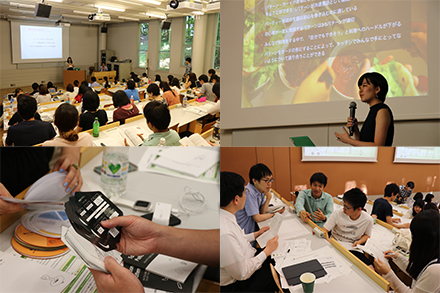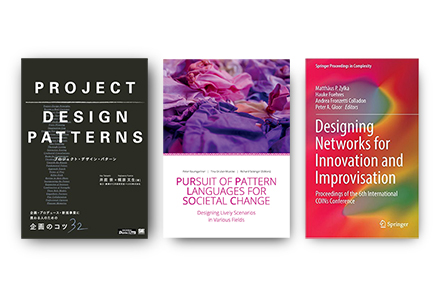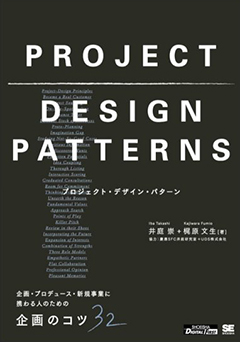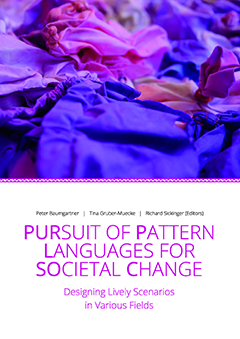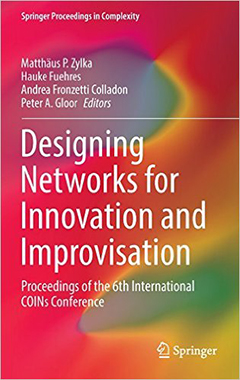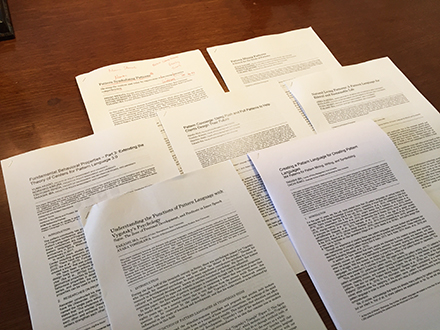Seminar Syllabus: Iba Lab B (GIGA), 2018 Spring
Iba Lab B (GIGA) - Natural & Creative Living Lab
Global Collaboration to Empower People with Creative Languages
(Thursday 3rd period, 2018 Spring semester)
Entry submission deadline: Jan 19th
Interview Session: Jan 24th
Purpose
You consist of a multitude of interests big and small, major and minor. Yet you most likely have learned that to achieve your highest potential, you should focus on improving just your best interest, and your other interests are less important.
When you graduate through Iba Lab, you will become a change maker, someone to make new waves with Creative Languages in various domains---such as learning, presentation, collaboration, project design, education, welfare, cooking, parenting, open dialogue… You will hone your skills with Creative Languages--a set of languages that illuminate and advise people to take on proactive attitudes towards achieving their desired qualities. You will connect with other practitioners of Creative Languages through the international conferences you attend when you present your work.
Creative Languages, produced here in Iba Lab, redefine our notions of potential, pointing the lens at the sum of all our “creative” potential. These languages open the possibility of realizing even your tiny interests, without sacrificing your important interests. We create Creative Languages to help others create a “creative” society. As opposed to other lab (kenkyukai) focused on social entrepreneurship or social innovation, Iba Lab targets daily life style practices to steer attitudes to be more “creative.”
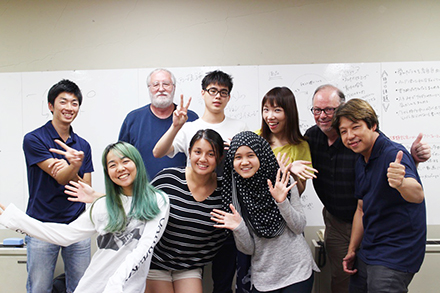
[Types of Creative Languages]
Pattern Language is a language that can raise the quality of life by describing practical knowledge in ways that can be shared and used by others. It is created through specific processes, such as pattern mining, pattern clustering, pattern writing and pattern illustrating. We also apply pattern language in dialogue workshops to communicate and describe solutions to problems under certain condition in particular contexts. See more details in this chapter (PDF).
Style Language is a language for showing a diversity of styles and ways things are done in a certain activity. It is not to be abstracted and creates clues or hints to live by, so It allows us to communicate and understand other people’s ways of conducting activities. For example, to share many families’ styles of living, we created “Family Style Language.”
Fun Language is a language for a collection of perspectives and actions that allows people to enjoy a certain activity.
For example, for enjoyment of cooking, we created “Cooking Fun Language” and it shares the hidden enjoyment of cooking and shows different perspectives of cooking.
Future Language is a collection of words for describing our desirable vision of the future. Through dialogues in Future Language Workshop. we generate ideas for a better community or vision of the future. See more details in this paper (PDF).
Currently, this lab is open to both individual and group work, but the majority of the members conduct individual projects and research. Students presented their chosen topics or areas of study and constructed their own schedule and project design. For the future semesters, we strongly encourage group work but will continue to permit individual work.
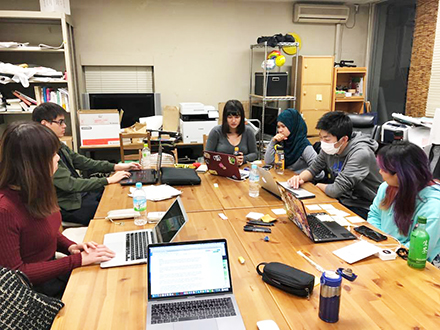
[WANTED! - Promoting A Welfare Pattern Language in HongKong and Taiwan]
One new project will start in the spring semester of 2018. This project is about promoting the Chinese version of the pattern language “Words for a Journey - The Art of Being with Dementia” (旅程的關鍵字——與認知障礙症共存的啟示)in Hong Kong and Taiwan. In Hong Kong and Taiwan, there has been a growing problem concerning people with dementia. With this pattern language, we can make the public more aware of how to deal with dementia. This project aims are:
(1) To hold workshops in Hong Kong and Taiwan
(2) To support people so that they will be able to hold the workshops by themselves
(3) To create the mechanism that makes other people want to use “Words for a Journey”
With that, more people can know about “Words for a Journey” and will be able to use it. Many workshops have already been done in Japan, so we feel that it needs to be spread to Hong Kong and Taiwan as well.
We are finding people who are interested in societal issues in Hong Kong and/or Taiwan. Chinese skills are not required for this project. We welcome you to join this project if you are interested in improving the society in Hong Kong or Taiwan. Please read this newspaper article in UK and our paper (PDF)about the pattern language.
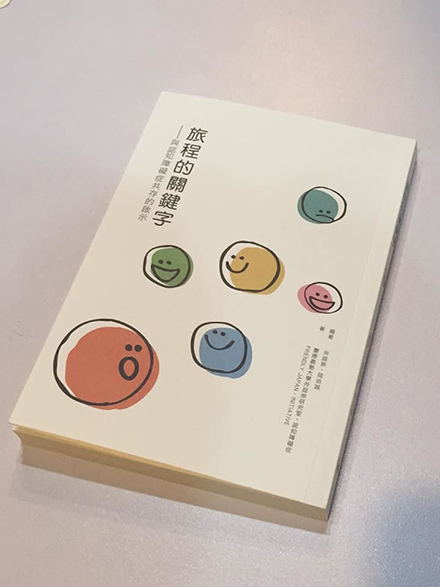
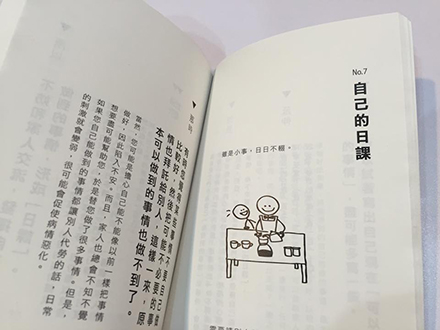
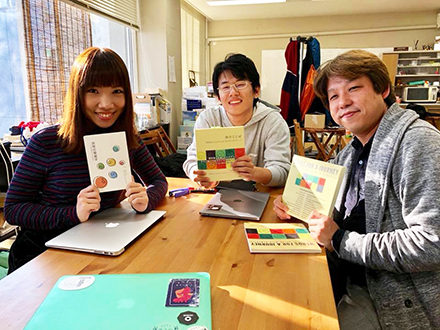
[WANTED!- Pattern Language of Children's Books.]
Nowadays, more and more children are turning to digital devices, rendering children's books to lose popularity and reduce in quality. There is one ongoing project that aims to raise awareness in the importance of children's books by describing the many elements found in these books in Creative Language format. The elements listed within this project explain why they are essential in children's books and how they assist in the development of children. People who are interested in analyzing children's books are welcome to join!
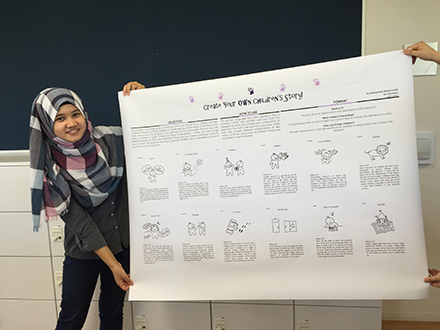
Number of Students
10
Requirement
The theme for our lab is creativity. We are looking for prospective lab members who are willing to commit creatively to the future!
Class Schedule
Official meeting will be on 3rd period of Thursday.
. In addition, Project activity will also take place on Thursday 3rd period.
Members are required to work on their projects outside of class time.
Special Note
With regards to the timing of enrollment, we highly encourage students to join during their early years at SFC (1st years and 2nd years are welcome). Joining early will allow students to gain research experience and get more opportunities. We are looking for members who are willing to study together with us in a long perspective. Breakthrough in knowledge and skills can be expected through long-term commitment.
Prof.Iba will be taking sabbatical leave starting from Sep 2018 to Aug 2019. During that time, Iba Lab B will be closed, but Iba Lab A (in Japanese) will still be running. Prospective students are welcome to join Iba Lab B in Spring 2018, but in the year following, they will no longer have the option of Iba Lab B. You are welcome to join Iba Lab A in that time.
Join us on opportunities to go on overseas trips to attend workshops and academic conferences. This year we will be visiting Germany in July, China in September, the US in October.
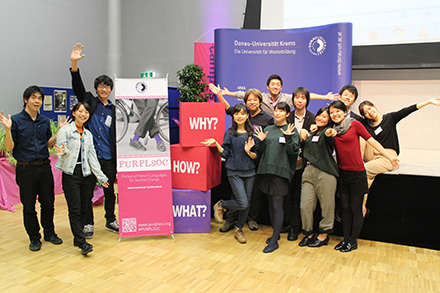
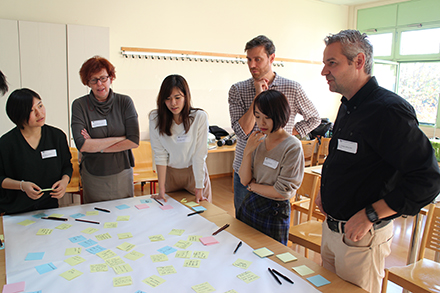
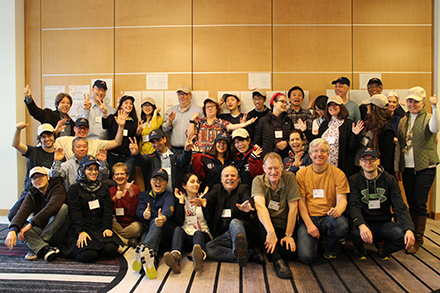
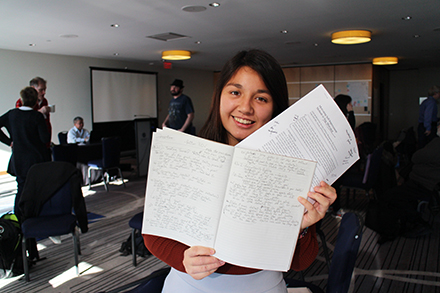
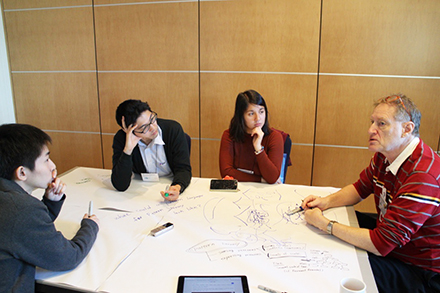
Screening Schedule
Entry submission deadline: Jan 19th
Interview Session: Jan 24th
Assignment
After reading through this syllabus thoroughly, please submit the entry assignment described below via email by January 19th.
Email to: ilab-entry [at] sfc.keio.ac.jp
Subject: Iba Lab B (2018 Spring) Entry
Please attach your entry assignment in a Word, Pages or PDF file.
Iba Lab B (2018 Spring) Entry
1. Name, Faculty, Grade, Student ID, login ID
2. Profile photo (for reference to interview session)
3. Topic of study you wish to work on in the lab. Reason for your entry. Your enthusiasm towards the project.
4. Other Labs (Kenkyukai) you are planning on joining next semester (if any)
5. Labs you have been a part of (if any)
6. Favorite classes you've taken so far (Multiple answers are welcome)
7. Courses by Prof. Iba which you have taken before (if any)
8. Any other introduction of yourself. (Circles, activities, interests, future visions, any other points to sell) *
The selection interview will be held based on the information given in the entry assignment.
Assesment Method
Grading will be based on participation, presentation, and project.
Materials & Reading List
References
Important Introductory Papers from Iba Lab
Iba Lab Patterns
Pattern Language Studies and Examples in Various Areas
Creativity, Collaboration, and Creative Society
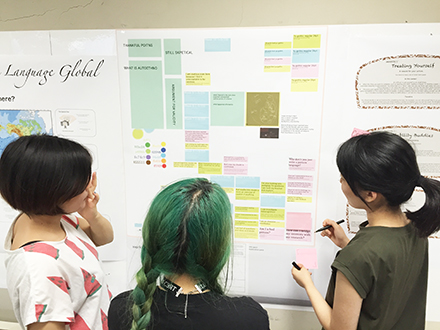
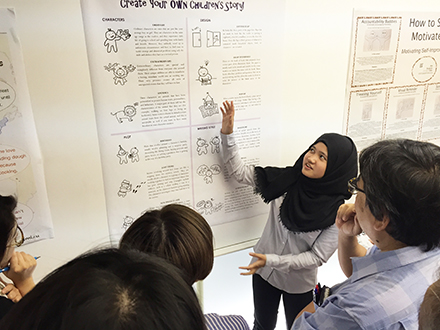
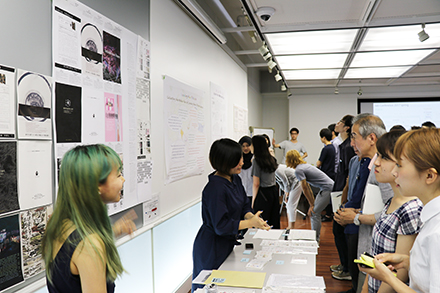
Related Courses
PATTERN LANGUAGE (GIGA)
Iba Lab A (in Japanese)
Contact
ilab-entry [at] sfc.keio.ac.jp
Iba Lab B (GIGA) - Natural & Creative Living Lab: Global Collaboration to Empower People with Pattern Languages
Global Collaboration to Empower People with Creative Languages
(Thursday 3rd period, 2018 Spring semester)
Purpose
You consist of a multitude of interests big and small, major and minor. Yet you most likely have learned that to achieve your highest potential, you should focus on improving just your best interest, and your other interests are less important.
When you graduate through Iba Lab, you will become a change maker, someone to make new waves with Creative Languages in various domains---such as learning, presentation, collaboration, project design, education, welfare, cooking, parenting, open dialogue… You will hone your skills with Creative Languages--a set of languages that illuminate and advise people to take on proactive attitudes towards achieving their desired qualities. You will connect with other practitioners of Creative Languages through the international conferences you attend when you present your work.
Creative Languages, produced here in Iba Lab, redefine our notions of potential, pointing the lens at the sum of all our “creative” potential. These languages open the possibility of realizing even your tiny interests, without sacrificing your important interests. We create Creative Languages to help others create a “creative” society. As opposed to other lab (kenkyukai) focused on social entrepreneurship or social innovation, Iba Lab targets daily life style practices to steer attitudes to be more “creative.”

[Types of Creative Languages]
Pattern Language is a language that can raise the quality of life by describing practical knowledge in ways that can be shared and used by others. It is created through specific processes, such as pattern mining, pattern clustering, pattern writing and pattern illustrating. We also apply pattern language in dialogue workshops to communicate and describe solutions to problems under certain condition in particular contexts. See more details in this chapter (PDF).
Style Language is a language for showing a diversity of styles and ways things are done in a certain activity. It is not to be abstracted and creates clues or hints to live by, so It allows us to communicate and understand other people’s ways of conducting activities. For example, to share many families’ styles of living, we created “Family Style Language.”
Fun Language is a language for a collection of perspectives and actions that allows people to enjoy a certain activity.
For example, for enjoyment of cooking, we created “Cooking Fun Language” and it shares the hidden enjoyment of cooking and shows different perspectives of cooking.
Future Language is a collection of words for describing our desirable vision of the future. Through dialogues in Future Language Workshop. we generate ideas for a better community or vision of the future. See more details in this paper (PDF).
Currently, this lab is open to both individual and group work, but the majority of the members conduct individual projects and research. Students presented their chosen topics or areas of study and constructed their own schedule and project design. For the future semesters, we strongly encourage group work but will continue to permit individual work.

[WANTED! - Promoting A Welfare Pattern Language in HongKong and Taiwan]
One new project will start in the spring semester of 2018. This project is about promoting the Chinese version of the pattern language “Words for a Journey - The Art of Being with Dementia” (旅程的關鍵字——與認知障礙症共存的啟示)in Hong Kong and Taiwan. In Hong Kong and Taiwan, there has been a growing problem concerning people with dementia. With this pattern language, we can make the public more aware of how to deal with dementia. This project aims are:
(1) To hold workshops in Hong Kong and Taiwan
(2) To support people so that they will be able to hold the workshops by themselves
(3) To create the mechanism that makes other people want to use “Words for a Journey”
With that, more people can know about “Words for a Journey” and will be able to use it. Many workshops have already been done in Japan, so we feel that it needs to be spread to Hong Kong and Taiwan as well.
We are finding people who are interested in societal issues in Hong Kong and/or Taiwan. Chinese skills are not required for this project. We welcome you to join this project if you are interested in improving the society in Hong Kong or Taiwan. Please read this newspaper article in UK and our paper (PDF)about the pattern language.



[WANTED!- Pattern Language of Children's Books.]
Nowadays, more and more children are turning to digital devices, rendering children's books to lose popularity and reduce in quality. There is one ongoing project that aims to raise awareness in the importance of children's books by describing the many elements found in these books in Creative Language format. The elements listed within this project explain why they are essential in children's books and how they assist in the development of children. People who are interested in analyzing children's books are welcome to join!

Number of Students
10
Requirement
The theme for our lab is creativity. We are looking for prospective lab members who are willing to commit creatively to the future!
Class Schedule
. In addition, Project activity will also take place on Thursday 3rd period.
Special Note





Screening Schedule
Entry submission deadline: Jan 19th
Interview Session: Jan 24th
Assignment
After reading through this syllabus thoroughly, please submit the entry assignment described below via email by January 19th.
Email to: ilab-entry [at] sfc.keio.ac.jp
Subject: Iba Lab B (2018 Spring) Entry
Please attach your entry assignment in a Word, Pages or PDF file.
Iba Lab B (2018 Spring) Entry
1. Name, Faculty, Grade, Student ID, login ID
2. Profile photo (for reference to interview session)
3. Topic of study you wish to work on in the lab. Reason for your entry. Your enthusiasm towards the project.
4. Other Labs (Kenkyukai) you are planning on joining next semester (if any)
5. Labs you have been a part of (if any)
6. Favorite classes you've taken so far (Multiple answers are welcome)
7. Courses by Prof. Iba which you have taken before (if any)
8. Any other introduction of yourself. (Circles, activities, interests, future visions, any other points to sell) *
The selection interview will be held based on the information given in the entry assignment.
Assesment Method
Grading will be based on participation, presentation, and project.
Materials & Reading List
References
- Takashi Iba, “Pattern Language 3.0 and Fundamental Behavioral Properties,” in Pursuit of Pattern Languages for Societal Change. Designing Lively Scenarios in Various Fields, eds by Peter Baumgartner, Tina Gruber-Muecke, Richard Sickinger, Berlin: epubli, 2016, pp.200-233 [ Book PDF ]
- Takashi Iba, “Pattern Languages as Media for Creative Dialogue: Functional Analysis of Dialogue Workshops” in PURPLSOC: The Workshop 2014, eds by Peter Baumgartner, Richard Sickinger, Berlin: epubli, 2015, pp.236-255 [ Book PDF ]
- Takashi Iba, “Future Language for Collaborative Design,” PUARL Conference 2016, USA, Oct., 2016 [ Paper PDF ]
- Takashi Iba, Taichi Isaku, “Creating a Pattern Language for Creating Pattern Languages: 364 Patterns for Pattern Mining, Writing, and Symbolizing,” 23rd Conference on Pattern Languages of Programs (PLoP2016), USA, Oct., 2016 [ Paper PDF ]
- Takashi Iba, “An Autopoietic Systems Theory for Creativity,” Procedia - Social and Behavioral Sciences, Vol.2, Issue 4, 2010, pp.305–6625. [ Paper PDF ]
- Takashi Iba with Iba Lab, Learning Patterns: A Pattern Language for Creative Learning, CreativeShift Lab, 2014
- Takashi Iba with Iba Lab, Presentation Patterns: A Pattern Language for Creative Presentations, CreativeShift Lab, 2014
- Takashi Iba with Iba Lab, Collaboration Patterns: A Pattern Language for Creative Collaborations, CreativeShift Lab, 2014
- Takashi Iba & Makoto Okada (eds), Iba Lab., and DFJI (Dementia Friendly Japan Initiative), Words for a Journey: The Art of Being with Dementia, CreativeShift Lab, 2015
- Tomoki Furukawazono & Takashi Iba, Survival Language Project, Survival Language: A Pattern Language for Surviving Earthquakes, CreativeShift Lab, 2015
- Eri Shimomukai & Sumire Nakamura with Takashi Iba, Change Making Patterns: A Pattern Language for Fostering Social Entrepreneurship, CreativeShift Lab, 2015
- Kaori Harasawa, Natsumi Miyazaki, Rika Sakuraba, & Takashi Iba, A Tale of Pattern Illustrating, CreativeShift Lab, 2015
- Takashi Iba with Iba Lab, Pattern Illustrating Patterns: A Pattern Language for Pattern Illustrating, CreativeShift Lab, 2015
- Tetsuro Kubota, Yuji Harashima, Haruka Mori, Tsuyoshi Ishida, Kaori Harasawa, and Takashi Iba, “Project Design Patterns: Patterns for Designing Architectural Projects,” 5th Asian Conference on Pattern Languages of Programs (AsianPLoP2016), Taiwan, Mar., 2016 [ Paper PDF ]
- Haruka Mori, Yuji Harashima, Tsuyoshi Ishida, Ayaka Yoshikawa, Takashi Iba, “Project Design Patterns: Sharing the Practices in Successful Projects,” PUARL Conference 2016, USA, Oct., 2016 [ Paper PDF ]
- Yuma Akado, Shiori Shibata, Ayaka Yoshikawa, Akimitsu Sano, and Takashi Iba, “Cooking Patterns: A Pattern Language for Everyday Cooking,” 5th Asian Conference on Pattern Languages of Programs (AsianPLoP2016), Taiwan, Mar., 2016 [ Paper PDF ]
- Alice Sasabe, Taichi Isaku, Tomoki Kaneko, Emi Kubonaga, and Takashi Iba, “Parenting Patterns: A Pattern Language for Growing with your Child,” 5th Asian Conference on Pattern Languages of Programs (AsianPLoP2016), Taiwan, Mar., 2016 [ Paper PDF ]
- Arisa Kamada, Rina Kato, Yuma Akado, Takashi Iba, “Natural Living Patterns: A Pattern Language for Ethical and Sustainable Life,” 23rd Conference on Pattern Languages of Programs (PLoP2016) USA, Oct., 2016 [ Paper PDF ]
- Takashi Iba, Aya Matsumoto, Arisa Kamada, Nao Tamaki, and Tomoki Kaneko, “A Pattern Language for Living Well with Dementia: Words for a Journey,” International Journal of Organisational Design and Engineering, Volume 4, No. 1/2, 2016, pp.85-112
- Christopher Alexander, The Timeless Way of Building, Oxford University Press, 1979
- Christopher Alexander, Sara Ishikawa, and Murray Silverstein, A Pattern Language: Towns, Buildings, Construction, Oxford University Press, 1977
- Christopher Alexander, Murray Silverstein, Shlomo Angel, Sara Ishikawa, Denny Abrams, The Oregon Experiment, Oxford University Press, 1975
- Christopher Alexander with Howard Davis, Julio Martinez, Don Corner, The Production of Houses, Oxford University Press, 1985
- Christopher Alexander, The Nature of Order, BOOK ONE: The Phenomenon of Life, The Center for Environmental Structure, 2002
- Christopher Alexander, The Nature of Order, Book 2: The Process of Creating Life, The Center for Environmental Structure, 2003
- Mary Lynn Manns, Linda Rising, More Fearless Change: Strategies for Making Your Ideas Happen, Addison-Wesley Professional, 2015
- James O. Coplien, Neil B. Harrison, Organizational Patterns of Agile Software Development, Prentice Hall, 2004
- Kent Beck, Cynthia Andres, Extreme Programming Explained: Embrace Change, 2nd Edition, Addison-Wesley; 2nd edition, 2004
- Takashi Iba, “Sociological Perspective of the Creative Society” (Chapter 4) in Designing Networks for Innovation and Improvisation, eds by Matthäus P. Zylka, Hauke Fuehres, Andrea Fronzetti Colladon, Peter A. Gloor, Springer International Publishing, 2016, pp.29-428
- Takashi Iba, Ayaka Yoshikawa, Tomoki Kaneko, Norihiko Kimura, Tetsuro Kubota, “Pattern Objects: Making Patterns Visible in Daily Life” (Chapter 11) in Designing Networks for Innovation and Improvisation, eds by Matthäus P. Zylka, Hauke Fuehres, Andrea Fronzetti Colladon, Peter A.
- Gloor, Springer International Publishing, 2016, pp.105-1128
- Haruka Mori, Norihiko Kimura, Shuichiro Ando, Takashi Iba, “Pattern Concierge: Using Push and Pull Patterns to Help Clients Design Their Future,” 23rd Conference on Pattern Languages of Programs (PLoP2016), USA, Oct., 2016 [ Paper PDF ]
- Takashi Iba, Ayaka Yoshikawa, “Understanding the Functions of Pattern Language with Vygotsky’s Psychology: Signs, The Zone of Proximal Development, and Predicate in Inner Speech,” 23rd Conference on Pattern Languages of Programs (PLoP2016), USA, Oct., 2016 [ Paper PDF ]
- Takashi Iba, Ayaka Yoshikawa, “Constructing the Philosophy of Pattern Language: From the Perspective of Pragmatism,” PUARL Conference 2016, USA, Oct., 2016 [ Paper PDF ]
- Takashi Iba, “Using Pattern Languages as Media for Mining, Analysing, and Visualising Experiences,” International Journal of Organisational Design and Engineering (IJODE), Vol. 3, No.3/4., 2014
- Daniel H. Pink, A Whole New Mind: Why Right-Brainers Will Rule the Future, Riverhead Trade, 2006
- R. Keith Sawyer, Explaining Creativity: The Science of Human Innovation, 2nd Edition, Oxford University Press, 2012
- Mason Currey, Daily Rituals: How Artists Work, Knopf, 2013
- Carolyn Fleming, Jack Fleming, Thinking Places: Where Great Ideas Were Born, Trafford Publishing, 2007
- Daniel Goleman & Peter Senge, The Triple Focus: A New Approach to Education, more than sound, 2014
- Peter M. Senge, C. Otto Scharmer, Joseph Jaworski, Betty Sue Flowers, Presence: Human Purpose and the Field of the Future, Crown Business, 2008
- C. Otto Scharmer, Theory U: Leading from the Future as It Emerges: The Social Technology of Presenting, Berrett-Koehler, 2009
- Joseph Jaworski, Source: The Inner Path of Knowledge Creation, Berrett-Koehler Publishers, 2011
- Peter Gloor, Scott Cooper, Coolhunting: Chasing Down the Next Big Thing, AMACOM, 2007
- Peter Gloor, Coolfarming: Turn Your Great Idea into the Next Big Thing, AMACOM, 2010
- Keith Sawyer, Group Genius: The Creative Power of Collaboration, Basic Books, 2008
Etienne Wenger, Communities of Practice: Learning, Meaning, and Identity, Cambridge University Press, 1999
- Matthew Lipman, Thinking in Education, 2nd Edition, Cambridge University Press, 2003
- Ikujiro Nonaka, Hirotaka Takeuchi, The Knowledge-Creating Company: How Japanese Companies Create the Dynamics of Innovation, Oxford University Press, 1995
- Tom Kelley, Jonathan Littman, The Art of Innovation: Lessons in Creativity from IDEO, America's Leading Design Firm, Crown Business, 2001
- Neil Gershenfeld, Fab: The Coming Revolution on Your Desktop -- from Personal Computers to Personal Fabrication, Basic Books, 2007
- Niklas Luhmann, Social Systems, Stanford University Press, 1996
- Takashi Iba, “Sociological Perspective of the Creative Society,” 6th International Conference on Collaborative Innovation Networks Conference 2016 (COINs16), Italy, Jun., 2016; published in Chapter 4 of Designing Networks for Innovation and Improvisation (Springer Proceedings in Complexity), Zylka, M.P., Fuehres, H., Fronzetti Colladon, A., Gloor, P.A. (Eds.), Springer International Publishing, pp.29-428



Related Courses
PATTERN LANGUAGE (GIGA)
Iba Lab A (in Japanese)
Contact
ilab-entry [at] sfc.keio.ac.jp
Iba Lab B (GIGA) - Natural & Creative Living Lab: Global Collaboration to Empower People with Pattern Languages
井庭研だより | - | -
